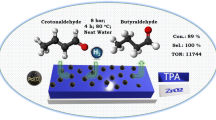Abstract
In this paper, we present a new protocol to synthesize dihydrodicyclopentadienes (DHDCP), via mono hydrogenation of dicyclopentadiene. With the use of Pd-nanoparticles as catalysts the products are formed highly selective under mild conditions. The ratio between the DHDCP and the tetrahydrodicyclopentadiene (THDCP) can be shifted by variation of the hydrogen pressure from 7:1 to 1:8, with high conversions of over 85 %. The product DHDCP is an essential building block in co-polymerizations. Also we show an easy recycling concept for the nanocatalyst by phase separation. With simple filtration the solid products DHDCP and THDCP can be isolated and the liquid catalyst phase can directly be reused. Over all recycling runs a steady high conversion of about 75 % was observed.
Graphical Abstract
Palladium nanoparticles in solution are an efficient catalyst for the selective monohydrogenation of dicyclopentadiene to the two dihydrodicyclopentadienes. High selectivities up to 95 % could be obtained after one hour under mild reaction conditions of 60 °C and 5 bar hydrogen pressure. Besides we could show an easy catalyst recycling concept by the liquid–solid two-phase technique.






Similar content being viewed by others
References
Hönicke D, Födisch R, Claus P, Olson M (2005) Cyclopentadiene and Cyclopentene. In: Ullmann’s Encyclopedia of Industrial Chemistry, 7th edition, electronic release, 7th edn. Wiley, Weinheim, pp 1–14
Morgan M, Chem Ind (London) (1996) 645–648
Meyer W (1976) Hydrocarbon Process. Int Ed 194:235–238
Zou J-J, Zhang X, Kong J, Wang L (2008) Fuel 87:3655–3659
Hao M, Yang B, Wang H, Liu G, Qi S (2010) J Phys Chem A 114:3811–3817
Cornils B, Payer R (1974) Chem Ztg 98:70–76
Webber KM (2005) Lyondell Chemical Company US 2005/0038303 A1
Dragutan V, Streck R (2000) Catalytic Polymerization of Cycloolefins. Elsevier, Amsterdam
Degenhardt H (1982) PhD thesis, RWTH Aachen University
Keim W, Behr A, Degenhardt H (1983) Chem Ing Tech 55:960–962
Antonova TN, Abramov IA, Feldblyum VS, Abramov IG, Danilova AS (2009) Pet Chem 49:366–368
Liu G, Mi Z, Wang L, Zhang X, Zhang S (2006) Ind Eng Chem Res 45:8807–8814
Dash P, Dehm NA, Scott RWJ (2008) J Mol Catal A 286:114–119
Nguyen B, Brown JM (2009) Adv Synth Catal 351:1333–1343
Gwynn M (1939) J Am Oil Chem Soc 16:25–28
Palczewska W (1975) Catalytic Reactivity of Hydrogen on Palladium and Nickel Hydride Phases. In: Eley DD, Pines H, Weisz PB (eds) Advances in Catalysis. Academic Press, New York, pp 245–291
Aston JG, Mitacek P Jr (1962) Nature 195:70–71
Somorjai GA, Jeong Y (2008) Top Catal 49:126–135
Belkacemi K, Boulmerka A, Arul J, Hamoudi S (2006) Top Catal 37:113–120
Gual A, Godard C, Castillón S, Claver C (2010) Dalton Trans 39:11499–11512
Roucoux A, Schulz J, Patin H (2002) Chem Rev 102:3757–3778
Tsuji Y, Fujihara T (2007) Inorg Chem 46:1895–1902
Crespo-Quesada M, Cardenas-Lizana F, Dessimoz A-L, Minsker LK (2012) ACS Catal. 2:1773–1786
Starkey-Ott L, Finke RG (2007) Coord Chem Rev 251:1075–1100
Schwarze M, Keilitz J, Nowag S, Parapat RY, Haag R, Schomäcker R (2011) Langmuir 27:6511–6518
Behr A, Schmidke H (1993) Chem Ing Tech 65:568–569
Behr A, Lux A (2012) (in preparation)
Astruc D (2007) Inorg Chem 46:1884–1894
Acknowledgments
We thank Iris Henkel for ICP-OES measurements and Monika Meuris (Group of Prof. Tiller) for TEM measurements and Jens Beneken (Group of Prof. Rehage) for supports in DLS measurements. This work was financially supported by the DFG (Deutsche Forschungsgemeinschaft).
Author information
Authors and Affiliations
Corresponding author
Electronic supplementary material
Below is the link to the electronic supplementary material.
Rights and permissions
About this article
Cite this article
Behr, A., Manz, V., Lux, A. et al. Highly Selective Mono-hydrogenation of Dicyclopentadiene with Pd-nanoparticles. Catal Lett 143, 241–245 (2013). https://doi.org/10.1007/s10562-013-0960-3
Received:
Accepted:
Published:
Issue Date:
DOI: https://doi.org/10.1007/s10562-013-0960-3




